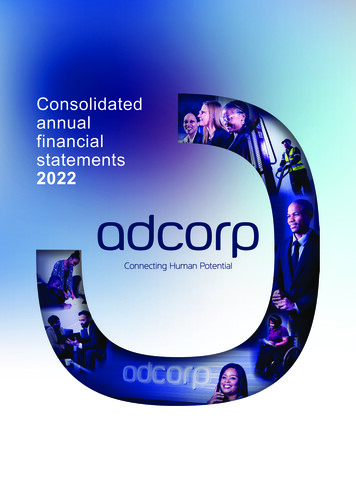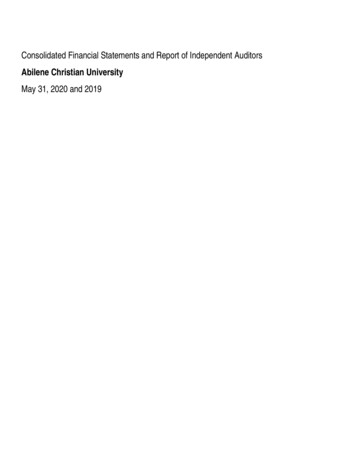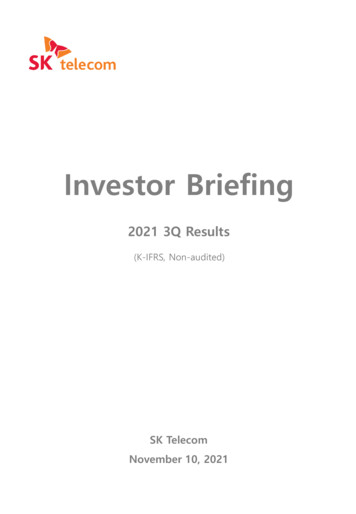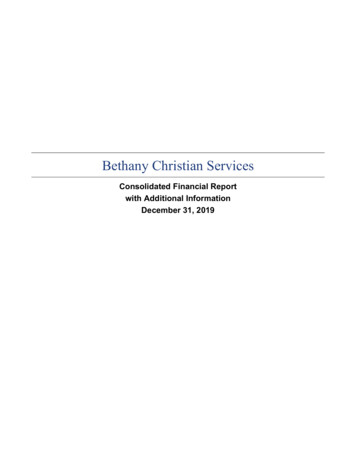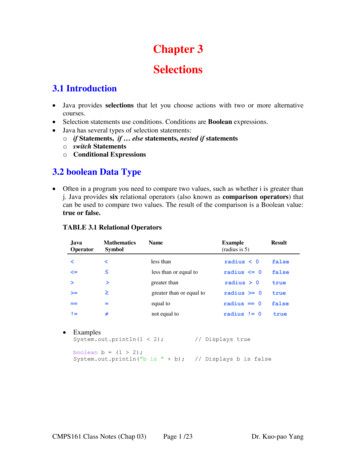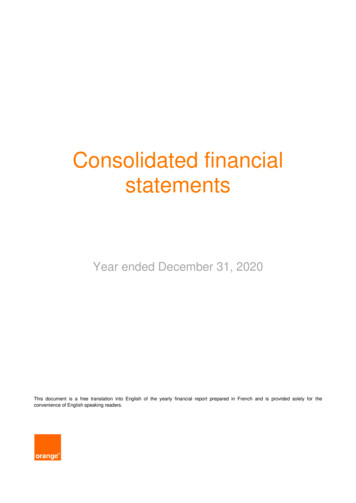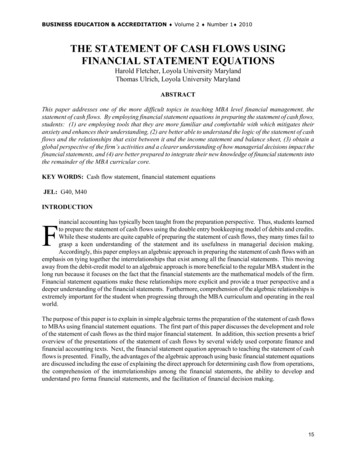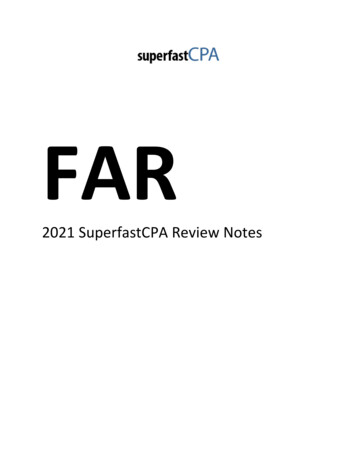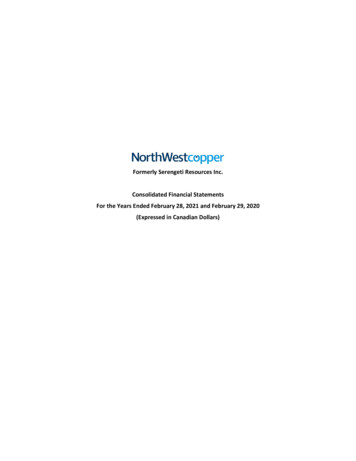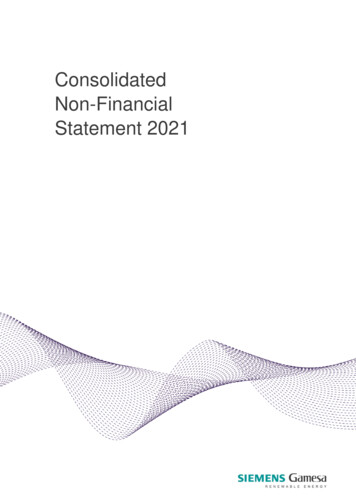
Transcription
ConsolidatedNon-FinancialStatement 2021
Consolidated Non-Financial Statement 2021Key figuresRevenues ( million)EBIT pre PPA and I&R costs ( million)Net profit ( million)Net financial debt (NFD) ( million)Equivalent MW soldFY18FY19FY20FY21Var. 810,99510%6,2349,8958,76710,16416%MW installed (cumulative)88,84098,735107,502117,6669%MW fleet under maintenance56,72560,02874,24079,1997%No. suppliers17,05117,89018,93219,3632%No. suppliers invoicing below 10k /y8,8748,9019,4839,401-1%Procurement volume ( 6,1820%Lost time injury frequency rate - LTIFR2.071.671.361.435%Total recordable injury rate - TRIR5.104.713.143.130%% women in workforce18.9018.7918.7619.102%% women in management positions10.7910.2411.6912.9211%Employee hiring2,4664,4984,9323,750-24%Employee exits4,8533,1453,2753,79416%MW installed (period)98HeadcountTraining hours (thousands)619905840555-34%Charitable contributions ( %Energy consumption (TJ)Energy consumption rate (GJ/MW)168127137114-18%Renewable electricity use (share in %)71.761.599.9100.00%Water consumption (x1,000 m3)4466675225536%Waste generated 928.83%Waste intensity (t/MW installed)CO2 emissions (kt CO2)CO2 emissions intensity (t/MW installed)9.87.13.22.8-13%CO2 displaced (million t CO2)23325928132917%Effluent generation (x1,000 m3)45132934249244%United Nations Global Compact --- -BBBBAA-Dow Jones Global Sustainability IndexFTSE4Good IndexEthibel Excellence Europe IndexEuronext Vigeo IndexBloomberg Gender Equality IndexMSCI ESG rating--2
Consolidated Non-Financial Statement 2021ContentsA. Our CompanyA.1 Siemens Gamesa at a GlanceA.3 Business Environment459A.4 Corporate Strategy11A.5 Risk Management12A.6 Corporate Governance14A.7 ESG: Ratings and Sustainability Indexes16A.8 Sustainability18B. Social and Human Resources Related Matters21B1. Working at Siemens Gamesa22B2. Health & Safety24B3. Diversity and Equal Opportunity28B4. Labor Relations33B5. Talent Management and Learning35B6. Compensation & Benefits39C. Environmental Matters41C1. Environmental Management System42C2. Climate Change46C3. Sustainable Use of Resources53D. Fight against Corruption and Bribery. Respect for Human Rights57D1. Ethics, Integrity and Anti-Corruption58D2. Human Rights61E. Information about Society63E1. Social Commitment64E2. Memberships and associations68E3. Responsible Supply Chain70E4. Responsible Tax74F. About this Report76G. Materiality Analysis78H. Tables, Facts and Figures81I. Law 11/2018 Content Index102J. List of End Notes1073
Consolidated Non-Financial Statement 2021Section A. Our CompanyA. Our Company4
Consolidated Non-Financial Statement 2021Section A. Our CompanyA.1 Siemens Gamesa at a GlanceA1.1 About usA1.2 Mission, Vision and Values[L11-G01] Siemens Gamesa is a leading supplier of wind powersolutions to customers all over the globe. Siemens Gamesa worksat the heart of the global energy revolution.[102-16] Our Company mission "We make real what matters Clean energy for generations to come" and our vision to "Be theglobal leader in the renewable energy industry driving the transitiontowards a sustainable world" define the foundation on which ourshared corporate culture will grow as we become more and moreintegrated.With a leading position in onshore, offshore, and service, our teamworks in partnerships across 90 countries to engineer, build anddeliver powerful, reliable wind energy solutions and services.A global business with a strong local footprint, we have installedmore than 107 GW and keep the lights on across the world,producing clean sustainable energy to power homes, schools,hospitals and keep us moving wherever we go.Siemens Gamesa operates with a flexible business model andorganizes its business in two segments: i) Wind Turbines(comprising Onshore and Offshore), which covers the design,development, manufacturing and installation of wind turbines, andii) Service.[L11-G02] [102-4] Siemens Gamesa is present in more than 90countries around the world, and its turbines are installed in 79countries. It operates more than 15 manufacturing plants in over 10countries and has approximately 40 sales offices.This is underpinned by six values: Results orientation: Results are relevant, delivered in a timelymanner and at an appropriate cost. Customer focus: Think from a customer's perspective abouthow we can excel in delivery. Innovativeness: New solutions for customers and ourselves. Impactful leadership: Inspiring our people and exemplifyingthe culture and common values. Ownership attitude: People are motivated and engaged andsee themselves as drivers of business success. Valuing people: Valuing the importance of the individual.[102-8] At the end of the reporting period (September 30, 2021),the Company had 26,182 employees (26,114 employees in fiscalyear 2020).Figure 1 - Siemens Gamesa global footprint5
Consolidated Non-Financial Statement 2021Section A. Our CompanyA1.3 Legal Name and Ownership[102-1] The corporate legal name Siemens Gamesa RenewableEnergy, S.A. has been in effect since June 20, 2017 and was dulyregistered on July 18, 2017. The name was published in the StockExchange Bulletin on July 21, 2017. The shares have been listedas Siemens Gamesa Renewable Energy, S.A. since July 24, 2017.[102-5] Siemens Gamesa is listed on the Madrid, Barcelona,Valencia, and Bilbao Stock Exchanges and is part of the Ibex 35index. The significant shareholders are currently Siemens EnergyAG, indirectly holding 67% and Blackrock Inc., with 3% of the sharecapital1,. The free float is 30%.The capital stock of Siemens Gamesa Renewable Energy, S.A.amounts to 115,794,374.94, consisting of 681,143,382 fullysubscribed and paid uncertificated shares of common stock with avalue per share of 0.17, all with identical rights and comprising asingle class and series.[102-7] The consolidated revenue in FY21 was 10,198 million( 9,483 million in FY20). All the economic and financial informationof Siemens Gamesa Renewable Energy S. A. and its subsidiariesis available in the Consolidated Financial Statements andManagement Report for the period ended September 30, 2021, itsfiscal year-end. [201-1][102-3] For legal purposes, Siemens Gamesa Renewable Energy,S.A.'s corporate details are as follows: “SIEMENS GAMESARENEWABLE ENERGY, S.A., a company duly incorporated underthe laws of Spain, with registered office at Parque Tecnológico deBizkaia, Building 222, Zamudio, Biscay, Spain and registered withthe Mercantile Register of Biscay in Volume 5139, Folio 60, PageBI-56858, and with VAT registration number A-01011253”.A.1.4 Products and Services[102-2] [102-6] The core business portfolio of Siemens Gamesacomprises wind turbines for onshore and offshore wind powerplants as well as a wide range of services. These business linesallow SGRE to be present across the wind value chain, offering awide range of products and services for different project types andsite conditions.Siemens Gamesa develops and manufactures wind turbines whichare suitable for a broad range of wind speeds (low, medium andhigh wind) and a full spectrum of weather conditions, and whichcan fulfill specific local requirements. Every wind generationlocation presents specific challenges which require the choice ofthe most appropriate product. To meet the specific needs of itscustomers, it offers versatile solutions for onshore and offshorepower plants. According to its “one segment, one technology”strategy, it uses mainly geared technology for onshore and directdrive technology for offshore wind turbines. In direct drivetechnology, a low-speed permanent magnet replaces the gearbox,coupling and high-speed generator, combining simplicity with ahigh level of efficiency.With wind turbines installed in 79 countries worldwide, totallingmore than 117 GW, and a full range of product platforms, theCompany sees itself as one of the main global technology leadersin the multi-megawatt wind turbine segment. Siemens Gamesa hasinstalled more than 1 GW of wind turbines in each of the followingcountries as of September 30, 2021 (based on cumulative installedcapacity figures, including all its onshore and offshore wind turbinesfor each country): Brazil, Canada, Chile, China, Denmark, Egypt,France, Germany, India, Ireland, Italy, Mexico, Morocco,Netherlands, Norway, Poland, Spain, Sweden, Turkey, UnitedKingdom and United States.Innovation is a key driver in the wind energy sector. SiemensGamesa believes it is at the forefront of technological developmentand innovation, and that it has one of the most comprehensive windturbine and service portfolios in the sector, enabling it to minimizethe LCoE (Levelized cost of energy) and provide optimal returns forits customers.The Wind Turbines business generated total revenue in FY21 inthe amount of 8.3 billion ( 7.7 billion in FY20), that is 81% of itstotal revenue, of which 5.0 billion is attributable to Onshore and 3.3 billion to Offshore. The Service business generated totalrevenue in the amount of 1.9 billion ( 1.7 billion in FY20) or 19%of Siemens Gamesa's total revenue), in fiscal year 2021. [See Table2 - Revenues by segment]Onshore Wind Turbines: Siemens Gamesa’s onshore approachfocuses on geared technology, in which it has extensive knowledgeand expertise. Its onshore portfolio relies on proven concepts withan extensive track record in the market and which offer high levelsof reliability, such as the combination of a three-stage gearbox anda doubly-fed induction generator. Other advantages of its turbinesare robustness, a modular, flexible design, and flexible powerratings for optimum adaptation and maximization of production atdifferent kinds of sites and in all wind conditions.6
Consolidated Non-Financial Statement 2021Section A. Our CompanyFigure 2 - Siemens Gamesa activitiesOnshoreOffshoreService99.0 GW installed worldwide18.7 GW installed worldwide 3.3 billion revenues in FY2179.2 GW maintained 1.9 billion revenues in FY21 5.0 billion revenues in FY21Siemens Gamesa 5.XSG 14-200 DDHauma windfarm serviceOffshore Wind Turbines: Siemens Gamesa’s offshore approachis focused on direct drive technology, which is particularly suitablefor offshore conditions. Replacing the gearbox, main shaft and aconventional high-speed generator with a low-speed generatoreliminates two-thirds of the conventional drive train arrangement.As a result, the number of rotating and wear-prone parts is greatlyreduced, so that a direct drive wind turbine has 50% fewer movingparts than a comparable geared machine. The simple designreduces the likelihood of failures. The use of fewer moving parts inthe direct drive technology (compared to geared machines) alsomeans fewer spare parts are needed over the course of a windpower plant’s lifetime. [SeeTable 8 - Wind turbine installation track record by country / market (cumulative MW)]Service: The Service business is responsible for the management,monitoring and maintenance of wind power plants. SiemensGamesa has roughly 35,000 serviced turbines worldwide, withmore than 79 GW under maintenance (including approximately 12GW offshore and more than 67 GW onshore). It covers the fulllifetime of a turbine, from when a wind park is commissioned toassuring its successful performance over its life. Not only doesService ensure that turbines are operating at their maximumcapacity and generating their maximum potential energy to deliverclean energy globally, but it also develops innovative technologyusing big data to provide enhanced performance for our customers.Siemens Gamesa currently delivers high-quality O&M services witha global reach and has service operations in more than 60countries around the world through its five regional and two globalcompetence centers. [See Table 9 - Service track record (MW)]Figure 3 - Hull blade plantFigure 4 - Brande nacelle plantA.1.5 Manufacturing BaseSiemens Gamesa manufactures wind turbines at its facilities inBrazil, China, Denmark, Germany, India, Morocco, Portugal, Spain,UK, and the United States. The Company has established atechnical presence close to its customers across the world. Itsmanufacturing base is designed to ensure an efficient productionprocess from the design of the wind turbines to the manufacturingof all critical components2. The decision as to whether a specificcomponent of a wind turbine should be produced in-house oroutsourced to third-party suppliers is determined by looking at threedifferent dimensions: capacity, cost and local content orindustrialization requirements. The Company operates bladefactories, nacelle assembly factories and other kind of factories(such as gearbox, converter and cabinet factories).A.1.6 Innovation, Research & DevelopmentWind turbines developed and manufactured by Siemens Gamesaare in permanent evolution, incorporating the latest technologicaladvances with the aim of increasing both power and performance.Overall, Siemens Gamesa employs approximately 3,500 dedicatedtechnology staff (13% of the total headcount). In fiscal year 2021,it spent 292 million on research and development ( 231 million in2020).Its R&D activities are carried out mainly through seven technologycenters located in Bangalore (India), Boulder (United States),Brande (Denmark), Hamburg (Germany), and Zamudio-Bilbao,7
Consolidated Non-Financial Statement 2021Section A. Our CompanyMadrid and Pamplona (all three in Spain). The R&D activities inZamudio-Bilbao and Pamplona are focused on the nacelle and itscomponents, while Brande and Hamburg focus also on blades. Thefacilities in Madrid and Brande are equipped with test benches fortesting and validating software systems for wind power,Photovotaic (lPV), energy storage and hybrid power systems. TheBangalore center serves global engineering and technologydemands pertaining to software and design engineering foronshore and offshore wind turbines, with a focus on newtechnologies such as machine learning and artificial intelligence,required to build the “smart” wind turbines of the next generation.Siemens Gamesa also works with renowned specializedinstitutions in the field of wind energy and fosters researchpartnerships across countries, organizations and disciplines. Inaddition, its partnership with Ørsted and the UK universities of Hull,Sheffield and Durham examines how renewable energy researchcan lower the costs of offshore wind power. This five-yearpartnership funded by the U.K. government under its Engineering& Physical Science Research Council enables Siemens Gamesaand its partner to develop new solutions relating to structural healthmonitoring and generator topologies.A.1.7 Significant Changes in Fiscal Year[102-10] There were no significant changes within the scope ofSiemens Gamesa in fiscal year 2021.A.1.9 CompetitionThe competitive situation for Siemens Gamesa differs in the threemarkets: onshore, offshore and service. It competes withinternationalOEMs(OriginalEquipment Manufacturers,companies that produce parts and equipment that may bemarketed by other manufacturers), Chinese OEMs and otherregional OEMs, primarily focused on their local markets.The market for onshore wind turbines is more fragmented, althoughconsolidation has increased concentration of market sharesoutside China.In the offshore market, there is a lower number of competitors dueto the relatively high entry barriers. However, price competition inwind turbines is also strong and influenced by the introduction ofauction mechanisms. Consolidation is moving forward in bothonshore and offshore markets. It is driven by market playersstriving for scale to address technology challenges (which increasedevelopment costs) and market accessibility challenges.There are about 30 wind turbine OEMs in the world. In generalterms, wind turbine OEMs can be categorized into three groups i)International players with global reach, e.g. Siemens Gamesa,Vestas (Denmark), GE Renewable Energy (France/United States)and Enercon and Nordex (Germany); ii) Chinese OEMs, e.g.Xinjiang Goldwind Science & Technology Co., Ltd. and Envision; iii)Other regional OEMs (mostly located in India), e.g. Suzlon EnergyLtd. and Inox Wind Ltd. (both in India).A.1.8 Our CustomersSiemens Gamesa customers are mainly companies that are activewithin the energy sector. The main customer categories are asfollows: Utilities – Companies that own wind farms and photovoltaicpowerplants to sell power to the distribution network to reachfinal energy demand.Independent Power Producers – Companies that own windfarms and photovoltaic powerplants in order to sell power toan off-taker (via a power purchasing agreement) with the aimof obtaining a financial return in excess of their cost of capital.Project Developers – Companies that develop a project tosell it to a future owner with the interest and financial capabilityto build and operate it.Others – Financial investors, oil & gas players, companiesthat need to consume green energy in order to meet theircorporate environmental targets, self-consumers, etc.With the energy transition, customer profiles have expanded, withother participants other than the traditional players (such as utilitiesand independent power producers) gaining in importance.CSIC, 1.8%Sinovel, 2.2%SeWind, 2.3%Others, 12.7%Vestas, 16.4%DEC, 2.4%Senvion, 2.5%TotalSuzlon, 2.6%760 GWUnited Power,2.9%MingYang,3.3%SiemensGamesa, 14.2%GeneralElectric, 11.8%Envision, 4.4%Goldwind, 9.3%Nordex, 4.4%Enercon, 6.8%Figure 5 - Top 15 OEMs: Global cumulative share, 2020 (Source: WoodMackenzie)8
Consolidated Non-Financial Statement 2021Section A. Our CompanyA.2 Business EnvironmentA.2.1 Megatrends Accelerating the Energy TransitionA.2.2 Impact of Megatrends[L11-G04] The energy sector is undergoing a transition fromconventional generation to a larger share of renewable generation.Global megatrends are accelerating this anttransformation. The traditional power (i.e. electricity) supplymodel was based on a centralized, conventional electricitygeneration structure (with dispatchable conventional power plantsmeeting power demand) and unidirectional grids (with electricityusually being transmitted from large-scale generators toconsumers). The economics of generation technology ensured astable business for conventional energy generation companies; inturn, the system ensured constant availability of electricity. Thistraditional model is now being challenged at many levels.Globalization and Global Economic Growth. Globalization is akey driver for the growth of international trade. The global tradevolume for goods roughly tripled between 2000 and 2019. Inaddition to globalization, a trend towards localization can also beobserved in certain countries, which may translate into localproduction and local content requirements.Rapid Urbanization. Globally, more people live in urban areasthan in rural areas. The share of urban population is expected toincrease to more than two-thirds by 2050. Urbanization is drivingdemand for food, water and energy in many places across theglobe. Sustainable urbanization requires that cities provide thenecessary infrastructure for energy, transportation andcommunication.Demographics and Social Change. The main trends hereinclude labor shortages, demand for healthcare, and changingconsumer demands. The global population could increase by over1 billion by 2030; by 2050, one-third of the population of 55countries will be aged over 60. A growing population is one of themain factors behind the increase in energy demand. Continuedrapid population growth also presents challenges for sustainabledevelopment.Climate Change and Resource Scarcity. Climate change anddecarbonization discussions — in which the energy transitionplays a key role — and the commitment to low or zero emissionstandards by countries and companies are gaining traction. TheIPCC (Intergovernmental Panel on Climate Change) has statedthat emissions must be cut to net zero by around 2050 in order tocap global warming at 1.5 C.Digitalization and Technological Breakthrough. Digitalizationopens new perspectives. The use of data is important for reducingcosts, increasing revenue, improving service quality, andintegrating customers and business partners. With growingdigitalization, the focus on cybersecurity is also increasing. Theenergy sector's increasingly complex grids are more prone tocyberattacks, making cybersecurity a key issue to ensure a secureenergy supply. Cybersecurity also plays an important role in thearea of remote services for power plants.With the rapid deployment of electricity generation fromrenewables, the world energy supply continues to transitiontowards an affordable, reliable and sustainable model. Because ofthe very low cost of most renewable power generationtechnologies (e.g. wind) in many jurisdictions compared toconventional power generation technologies and also of supportschemes (e.g. preferential feed-in), conventional power plantsincreasingly provide only the balance between power demand andrenewable power generation and, consequently, haveexperienced a reduction in operating hours.This transformation is driven by changes in market economicsand regulatory frameworks as well as more engagedcustomers and competitors, and many new trends in the energysector are also derived from or closely correlated with themegatrends described above. For example i) Investors areincreasingly shifting capital to sustainable funds, ii) Governmentsare setting new frameworks, driven by commitments such as thosein the Paris Agreement, iii) Companies and industries are makingambitious pledges, for example with respect to sustainabilitytargets, iv) Public opinion is also increasingly pushing for theadoption of more ambitious environmentally-friendly measures,and v) Customers are increasingly factoring companies'environmental practices into their purchasing decisions.We see a transition of the energy system towards decarbonizationin which renewables will become the main source of cheapelectricity and conventional technologies will be important toensure security of supply. We also see integrated intelligentnetworks that can continuously manage load shifts. Zero-emissionenergy technologies such as hydrogen will become important todecarbonize other sectors, such as mobility, industry andresidential and, therefore, to achieve climate protection goals. Weview increasing demand for energy and electricity,decarbonization, decentralization and digitalization as the trendsthat have the largest impact on our business.9
Consolidated Non-Financial Statement 2021Section A. Our CompanyA.2.3 Business RisksGlobal or local outbreaks of infectious diseases and otherpublic health crises. We have been affected by the fallout of theoutbreak of the recent Coronavirus pandemic. Risks stem not onlyfrom the immediate effect of such crises but also from anymeasures aimed at limiting their impact, including, but not limitedto, restrictions on travel, imposition of quarantines, prolongedclosures of workplaces, curfews and other social distancingmeasures, including the social impact of such measures.Competition and lower market prices. Markets face structuralchanges, moving away from fixed support regimes for renewableenergy generation towards market-based auction models wherecompeting developers bid for projects, with awards based on thelowest entry price and the lowest level of incentives required forthe project.Supply chain constraints. Supply chain risks, due to theexistence of critical components and services that could causedelays or cost increases in the production of Siemens Gamesawind turbines or the execution of its construction projects.Raw materials price increase: Exposure to risks relating tofluctuations in the prices of raw materials that could affect supplychain costs and project execution.Risks of project execution. Cost overruns, missed deadlines,failure to meet business requirements, raw material priceincreases or increase of logistic and transport costs.Risk of insufficient funding or difficulties in obtaining otherfinancing instruments and services, such as financing, securities,hedging instruments and insurance, from financial institutions forspecific projects or our whole business operations. This may be.due to financial institutions’ internal, industry-wide or policy-drivenprerequisites for all dimensions of ESG. Examples are the new‘lending criteria’ of the European Investment Bank (“EIB”) or thefuture alignment with the European Union’s (the “EU”) taxonomy.Political instability, international conflicts and new tradebarriers. Several components are manufactured in China and theU.S.- China trade conflict may have a negative impact on ourbusiness, including: interruptions of product manufacturingprocesses, delays in delivering products, claims for damages anddifficulties in replacing Chinese suppliers in time or ateconomically reasonable costs. Other scenarios include postBrexit relationship between UK and the EU, and potential risksfrom doing business in countries under embargoes or sanctionsby strategic countries.Extreme weather conditions due to climate change. Forexample, Siemens Gamesa had to adjust its profitability target inJanuary 2020 following unforeseen costs in a low triple-digit millioneuro amount relating to five onshore projects (1.1 GW) in northernEurope, mainly Norway, caused by adverse road conditions andthe unusually early onset of winter weather, which delayed projectexecution.Environmental, social and governance (ESG) standards.Compliance with certain ESG standards may pose additionalchallenges to our business. Our business and investmentdecisions increasingly consider environmental, social andgovernance (“ESG”) standards and expectations regardingenvironment (e.g. climate change and sustainability), socialconcerns (e.g. diversity and human rights), and corporategovernance issues (e.g. employee relations).10
Consolidated Non-Financial Statement 2021Section A. Our CompanyA.3 Corporate StrategyUnleashing the full potential of Siemens Gamesa 3 . With aleading position in all three areas of the wind business – onshore,offshore, and service – we are driving the global green energyrevolution and accelerating the efforts of our partners around theworld. We are a global market leader in offshore wind and leadseveral onshore markets across the Americas, Europe, Africa andAsia. Our service business leads the industry in operating,maintaining and optimizing turbines throughout their lifespan. Tounleash our full potential, we refreshed our corporate strategy,which aims to continue securing growth opportunities in ourprofitable Offshore and Service businesses, while driving aturnaround in Onshore. The strategy prioritizes profitability (overvolume), cash generation, efficiency and productivity in alloperations.While wind turbine manufacturers’ margins have been eroded byexternal factors — such as the introduction of auctions, globaltrade tensions, and the disruption caused by COVID-19 — thelong-term outlook for wind power is very favorable. According tothe International Energy Agency (IEA), renewable energies willaccount for more than 50% of the global capacity mix in 2040 andwind is expected to attract the highest investments in that period,according to BNEF. Strong growth is expected in the Offshore andService markets over the next decade, while demand in Onshorewill remain solid. Siemens Gamesa also expects prospects to bebolstered by the emergence of green hydrogen technologies, inwhich wind energy will play a leading role.According to the World Energy Outlook 2019 (International EnergyAgency-WEO 2019), cumulative wind capacity at the end of theperiod (2040) will amount to 1,850 GW, i.e. 150 GW above theprevious report's estimates (with more than 300 GW Offshore). Itis estimated that, over the next 20 years, average installations willbe 57 GW per year, almost 15% more than previously projected.[L11-G03] [G102-14] Siemens Gamesa has developed actionplans to take advantage of long-term opportunities and protectagainst long-term risks.Launched in 2020, the LEAP program set clear priorities: Innovation – Strive for technology leadership and businessmodel innovation. Productivity & Asset Management – Continued focus oncost-out and stringent cash management to optimizeprofitability and cash generation. Operational Excellence – Strengthen process and projectexecution discipline and achieve industry benchmark safetyand quality levels. Sustainability and People – Become the ‘go-to’ company inrenewable energy by setting the industry benchmark insustainability and in appeal as a place to work. Digitalization - Siemens Gamesa is investing in digitalizationwhich it believes is a key enabler for accelerating theachievement of its objectives.In this context, its key objectives for the period until 2023 focus on: Returning Onshore to sustainable profitability with aturnaround plan focused on the following priorities: (i) Focuson profitable volume and de-risking the business; (ii)Introduction of new leading technology; (iii) Reduction ofsupply chain complexity; (iv) Reinforcement of projectexecution capabilities; and (v) Reorganization to improveperformance. Capturing offshore market growth through a profitableleadership position with the following priorities: (i)technological differentiation; (ii) globalization with marketexpansion and early customer engagement; and (iii) focus onexecution excellence. Sustainably growing faster than the market in service,with the following priorities: (i) continuously develop newbusiness models in partnership with customers; (ii) focus oninnovation, productivity and operational excellence; and (iii)capture the potential of the profitable multi-brand business.Accordingly, Siem
Consolidated Non-Financial Statement 2021 Section A. Our Company 5 A.1 Siemens Gamesa at a Glance A1.1 About us [L11-G01] Siemens Gamesa is a leading supplier of wind power solutions to customers all over the globe. Siemens Gamesa works at the heart of the global energy revolution. With a leading position in onshore, offshore, and service, our team

